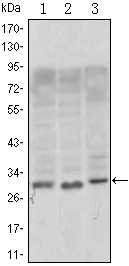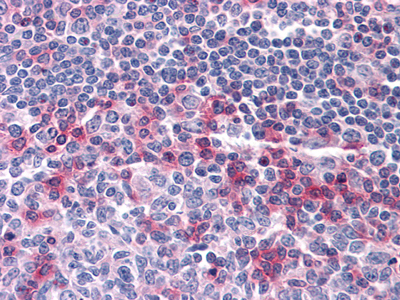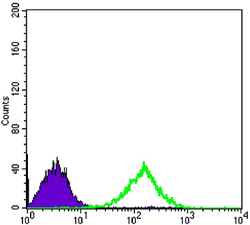CD69 Monoclonal Antibody
- Catalog No.:YM0131
- Applications:WB;IHC;IF;FCM;ELISA
- Reactivity:Human
- Target:
- CD69
- Gene Name:
- CD69
- Protein Name:
- Early activation antigen CD69
- Human Gene Id:
- 969
- Human Swiss Prot No:
- Q07108
- Mouse Swiss Prot No:
- P37217
- Immunogen:
- Purified recombinant fragment of human CD69 expressed in E. Coli.
- Specificity:
- CD69 Monoclonal Antibody detects endogenous levels of CD69 protein.
- Formulation:
- Liquid in PBS containing 50% glycerol, 0.5% BSA and 0.02% sodium azide.
- Source:
- Monoclonal, Mouse
- Dilution:
- WB 1:500 - 1:2000. IHC 1:200 - 1:1000. Flow cytometry: 1:200 - 1:400. ELISA: 1:10000.. IF 1:50-200
- Purification:
- Affinity purification
- Storage Stability:
- -15°C to -25°C/1 year(Do not lower than -25°C)
- Other Name:
- CD69;CLEC2C;Early activation antigen CD69;Activation inducer molecule;AIM;BL-AC/P26;C-type lectin domain family 2 member C;EA1;Early T-cell activation antigen p60;GP32/28;Leukocyte surface antigen Leu-23;MLR-3;CD antigen CD69
- Molecular Weight(Da):
- 23kD
- References:
- 1. EMBO J. 1997 Feb 17;16(4):673-84.
2. Cell Immunol. 2002 Nov;220(1):20-9.
3. Arch Biochem Biophys. 2005 Jun 1;438(1):11-20.
- Background:
- This gene encodes a member of the calcium dependent lectin superfamily of type II transmembrane receptors. Expression of the encoded protein is induced upon activation of T lymphocytes, and may play a role in proliferation. Furthermore, the protein may act to transmit signals in natural killer cells and platelets. [provided by RefSeq, Aug 2011],
- Function:
- developmental stage:Earliest inducible cell surface glycoprotein acquired during lymphoid activation.,function:Involved in lymphocyte proliferation and functions as a signal transmitting receptor in lymphocytes, natural killer (NK) cells, and platelets.,induction:By antigens, mitogens or activators of PKC on the surface of T and B-lymphocytes. By interaction of IL-2 with the p75 IL-2R on the surface of NK cells.,online information:CD69,PTM:Constitutive Ser/Thr phosphorylation in both mature thymocytes and activated T-lymphocytes.,similarity:Contains 1 C-type lectin domain.,subunit:Homodimer; disulfide-linked.,tissue specificity:Expressed on the surface of activated T-cells, B-cells, natural killer cells, neutrophils, eosinophils, epidermal Langerhans cells and platelets.,
- Subcellular Location:
- Membrane; Single-pass type II membrane protein.
- Expression:
- Expressed on the surface of activated T-cells, B-cells, natural killer cells, neutrophils, eosinophils, epidermal Langerhans cells and platelets.
- June 19-2018
- WESTERN IMMUNOBLOTTING PROTOCOL
- June 19-2018
- IMMUNOHISTOCHEMISTRY-PARAFFIN PROTOCOL
- June 19-2018
- IMMUNOFLUORESCENCE PROTOCOL
- September 08-2020
- FLOW-CYTOMEYRT-PROTOCOL
- May 20-2022
- Cell-Based ELISA│解您多样本WB检测之困扰
- July 13-2018
- CELL-BASED-ELISA-PROTOCOL-FOR-ACETYL-PROTEIN
- July 13-2018
- CELL-BASED-ELISA-PROTOCOL-FOR-PHOSPHO-PROTEIN
- July 13-2018
- Antibody-FAQs
- Products Images

- Western Blot analysis using CD69 Monoclonal Antibody against, Jurkat (1), L1210 (2) and TPH-1 (3) cell lysate.

- Immunohistochemistry analysis of paraffin-embedded human Tonsil tissues with AEC staining using CD69 Monoclonal Antibody.

- Flow cytometric analysis of Jurkat cells using CD69 Monoclonal Antibody (green) and negative control (purple).



